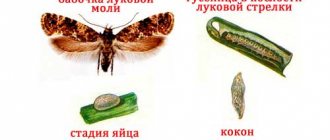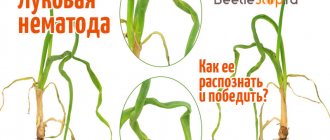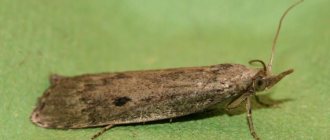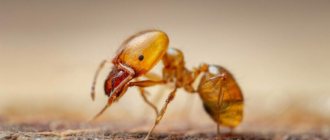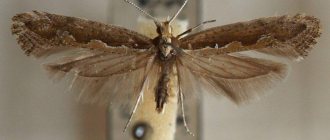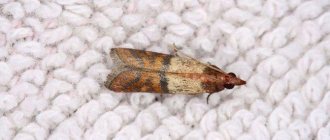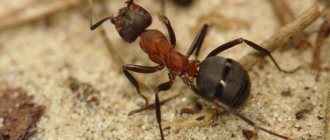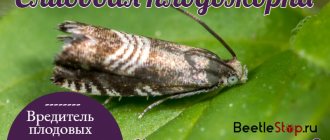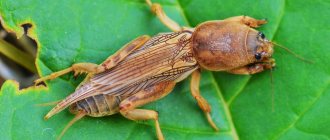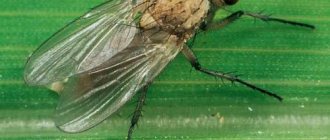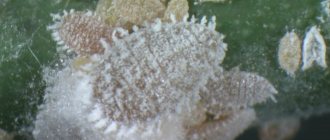While growing onions and garlic, every agronomist is faced with insects that can deteriorate the quality of the crop or even destroy it.
It is worth taking care of protecting plants from pests, starting with preparing the soil after harvesting the predecessor. Then you need to choose high-quality planting material, the optimal time for sowing and inspect the crops for pests as often as possible.
In this article, we will tell you which insects harm onions and garlic, and also consider effective methods of combating them.
General recommendations for protecting onions and garlic from harmful insects
1. First of all, you need to select varieties and hybrids that match the climate and growing area. 2. Crop rotation. Onion plants can be returned to the same field no earlier than after 3-4 years. Also, onion fields should be placed away from areas where onions or garlic previously grew. 3. For growing onion vegetables, it is best to choose sunny and well-ventilated fields. 4. Do not thicken crops or over-water, as this can serve as a favorable environment for insects. 5. Early sowing. The older the plants are by the time the harmful insects return, the less they will suffer from them. 6. Loosening row spacing during the growing season. 7. Periodic inspection of crops for the presence of pests, removal and subsequent destruction of damaged plants. 8. Destruction of plant residues after harvesting. 9. To prevent pests from getting into the storage, you need to collect onions and garlic in dry weather, dry them until the leaves completely dry out and dry upper scales form.
Recommendations for protecting onions from pests and diseases
Diseases
Downy mildew (peronospora)
The causative agent of the disease, the Peronospora fungus, infects onions during the growing season. The disease is especially dangerous for onion seeds in wet years.
The fungus overwinters in the form of a mycelium in the bulbs, without outwardly manifesting itself in any way. Can overwinter in plant debris. The mushroom enters the garden with infected bulbs planted in the ground. During the first 20-30 days, plants develop from infected bulbs without any external manifestations of the disease. However, along with the onion, the mycelium also grows. It penetrates into the leaves through the intercellular spaces. The disease appears on the leaves in the form of round, blurry yellowish spots, on which, in wet weather, a gray-violet coating of summer fungal spores appears. Sick plants are stunted, wilt, turn yellow, and may die. In dry weather, the development of the disease stops.
Wind and rain disperse the spores, infecting healthy plants. Once on a healthy plant, the spore grows into a mycelium, which penetrates into the tissue of a healthy leaf through stomata. After 10-15 days, a yellow oval spot with a coating of spores forms on the leaf at the site where the mycelium invades. Diseased leaves dry out. Later, the mycelium penetrates from the leaves into the bulb, where it will overwinter.
On onion seeds, the fungus infects the shoots, which turn yellow and break. In this case, the seeds on the inflorescences are either not formed at all or are formed puny.
Perennial speciesA species is an evolutionarily established set of individuals, characterized by a single... onions (batun, leek, chives) are a permanent site for the formation of spores. The mycelium overwinters in their roots.
Control measures. Rotation of crops: onions should return to their original place after 3-4 years. Planting onions in open areas well blown by the wind. If possible, remove nigella crops from other onion crops. Crops of perennial onion species should be isolated as much as possible from other onion plantings. Planting onions with bulbs not infected with peronospora. Removing diseased plants or diseased leaves during the growing season. Spraying seed plants and other onion plantings, except for onion plantings, with 1% Bordeaux mixture, oxychome or copper oxychloride. The period of spraying is at the first manifestation of the disease. Disinfection of planting material in one of the following ways:
- heating onion sets, turnips, samples obtained from infected crops at a temperature of +40... +43° C for 16 hours or at a temperature of +35... +37° C for 7 days. It is better to warm up the sets in the spring 12-14 days before planting;
- heating the planting material at a temperature of +40° C for 8 hours, and large bulbs for 16 hours. In this case, the mycelium in the bulbs dies.
Drying the onions in the garden until the leaves are completely dry and dry covering scales form on the bulbs. Removal of crop residues.
White rot of the bottom of onions and garlic
The causative agent of the disease is the Fusarium mushroom. The disease appears during the growing season. In diseased plants, during the period of bulb maturation, the leaves quickly die off, most of the roots rot, white mycelium grows on the bottom, and the bulb becomes soft and watery. Winter garlic plants dry out by the time the shoot shoots out. Dead plants are pulled out of the ground easily, without roots. In the storage facility, the disease continues to develop.
The fungus overwinters in the soil and in bulbs. Soil is the main source of infection. Perennial species also suffer from rot. A species is an evolutionarily established set of individuals characterized by a single ... onion.
Control measures. Carrying out agrotechnical measures aimed at increasing plant resistance to disease (maintaining crop rotation, loosening the soil, applying fertilizers, removing diseased plants, etc.).
Gray neck rot of onions
The causative agent of the disease is a fungus. Infection of the bulbs occurs in the beds shortly before harvesting, and the disease manifests itself during storage of the onions.
The spores of the fungus, falling on the lower dying leaves, germinate, and the mycelium penetrates the neck of the bulb. The presence of wounds on the leaves promotes infection. Later, during storage, the tissue in the neck of the bulb decomposes and emits an unpleasant odor. The scales of the bulb are covered with gray mold with small black granular sclerotia. The mycelium spreads throughout the bulb. The affected bulb shrinks. In storage, rot moves from diseased bulbs to healthy ones. High humidity and temperature during storage are favorable for the development of the fungus. The spread of the disease is facilitated by onion mites, which cause wounds to the bulbs. When infected bulbs are planted, diseased, pale yellow plants grow and soon die.
Sources of infection are landing! material and plant remains.
Control measures. Compliance with crop rotation with the return of onions to their original place no earlier than after 3-4 years. Careful collection and removal of plant residues from the garden. Deep digging of the soil in the fall with embedding of plant remains. Selection of healthy bulbs for planting, culling and destruction of diseased ones. Sow seeded onions as far as possible from the onion plantings. Early sowing and planting of onions. Harvesting onions when the leaves have completely yellowed, drying them in the sun, and in wet weather - under a canopy for 7-10 days. When trimming onions, leave a neck at least 3-4 cm long. Place well-dried onions with dried roots for storage. The best storage conditions for onions are air humidity 70-75% and temperature +1... +2° C.
Periodic sorting of onions during storage, removing diseased bulbs.
Bacterial rot of onions and garlic
The disease affects onion seeds and bulbs during storage. On the seed plants, the affected plants slow down their growth, the leaves and stems wither and turn yellow, and seeds are not formed. During storage, depressed areas appear on the fleshy scales of the bulbs, which stand out against the background of healthy tissue. Spots can be on both external and internal scales. Sometimes diseased and healthy scales alternate. Diseased tissues decompose and release an unpleasant odor.
Garlic is damaged during storage. Brown, depressed spots appear on the teeth. Sometimes the affected tissue looks like brown stripes running upward from the bottom of the tooth.
Control measures. Long-term drying of planting material before storage. Loosening the soil during the growing season of onions and garlic. Optimal watering rates (high humidity is favorable for the development of the disease). Removing diseased plants from beds. Selection for planting healthy bulbs and cloves of garlic.
Mosaic bow
The disease manifests itself during the growing season. The virus infects the leaves and inflorescences of onions.
Yellow-white or cream-colored elongated spots of diseased tissue appear on the leaves. Sometimes the leaves curl or become corrugated and may wilt and droop down.
On the seeds, in addition to the leaves, the inflorescences are affected. They become deformed, the pedicels grow of different lengths, long leaves or bulbs appear on the pedicels instead of flowers, and few or no seeds are produced.
The virus is transmitted from a diseased plant to a healthy one by aphids and mites. The virus is stored in the bulbs. Diseased bulbs have an elongated shape; when stored, they quickly germinate and rot. They are the main source of infection. Onion mosaic virus is not transmitted through seeds or through soil.
Control measures. Getting healthy onion sets. To do this, black onions are sown in areas remote from onion plantings on turnips, from onion seeds and from places where perennial onion species grow.
Fight against virus carriers - aphids, mites. Removal of diseased plants from onion and turnip plantings during the growing season.
Biological preparations for pest control of onion and garlic
| Drug name | Pest against which treatment is carried out | Consumption rate of the drug (kg/ha, l/ha) | Packaging |
| Aktofit k.e. (aversectin C, 0.2%) | Spider mites, thrips | 50-200 ml per 20 liters of water | 0.04 l, 0.1 l, 0.2 l, 0.4 l, 0.9 l |
| Bitoxibacillin, e.g. | Spider mite | 80-100 ml per 10 liters of water | 35 ml, 0.125 l, 1 l, 5 l, 10 |
| Verticillin | Spider mite | 100-500 ml/10 l water | 1 l |
| Nematophagin | Nematode | 0.1-0.3 ml per 10 liters of water | 0.33 l, 1 l, 5 l |
Harm
Although the main threat comes precisely from the yellow-green moth caterpillars, if you notice butterflies you also need to be wary: most likely, they are looking for a suitable place to lay eggs. The larvae that emerge from them will begin to feed on the inner pulp of the feathers, without touching the epidermis of the leaf. An external sign of such a lesion are longitudinal light stripes.
When the caterpillars have caused serious damage, their leaves begin to turn yellow and dry out at the tips. This disrupts the proper process of photosynthesis, which makes the plant weakened. If caterpillars are infested in onion sets, they climb into the bulbs and destroy them.
Chemical insecticides for pest control of onions and garlic
| Name of insecticide | Pest against which treatment is carried out | Consumption rate of the drug (kg/ha, l/ha) | Packaging |
| Aktara 25 WG, v.g. (thiamethoxam, 250 g/l) | Onion fly, tobacco thrips, onion secretive proboscis, hoverfly, leaf beetle (rattler) | 0,2-0,4 | 1.4 g, 6 g, 250 g |
| Apollo c.s. (clofentizine, 500 g/l) | Onion mite | 0,3-0,5 | 1 l, 5 l |
| Bi-58 new, k.e. (dimethoate, 400 g/l) | Ticks, thrips | 0,5-1,0 | 1 l, 5 l, 10 l |
| Vertimek 018 EC k.e. (abamectin, 18 g/l) | Thrips, spider mite | 0,8-1,2 | 10 ml, 100 ml, 1 l |
| Decis f-lux 25 EU, k.e. (deltamethrin, 25 g/kg) | Thrips, onion fly, onion hoverfly, onion muskellunge | 0,2-0,3 | 5 l |
| Exirel, S.E. (cyantranilprole, 100 g/l) | Thrips, onion fly | 0,75-1,0 | 250 ml, 1 l |
| Enzhio 247 SC, k.s. (lambda-cyhalothrin, 160 g/l + thiamethoxam, 141 g/l) | Onion fly, thrips | 0,18 | 3.6 ml, 100 ml, 5 l |
| Karate Zeon 050 EU, k.e. (lambda-cyhalotron, 50 g/l) | Onion fly | 0,15-0,4 | 5 l |
| Pirinex Super, k.e. (chlorpyrifos, 400 g/l + bifenthrin, 20 g/l) | Onion root mite | 0,8 | 1 l, 5 l |
| Movento k.s. (spirotetramat, 100 g/l) | Thrips | 0,75-1,0 | 1 l |
| Mospilan, v.p. (acetamiprid, 200 g/kg) | Onion cracker | 0,2-0,3 | 50 g, 0.2 kg, 0.4 kg, 1 kg |
| Commander, r.k. (imidacloprid, 200 g/l) | Onion cracker, thrips | 0,1 | 1 l |
| Lannat v.r. (methomyl, 200 g/l) | Tobacco onion thrips | 0,8-1,2 | 1 l, 5 l |
| Nissan, sp. (hexythiazox, 100 g/kg) | Onion root mite | 0,4-0,5 | 0.5 kg |
| Nurel D, Ph.D. (chlorpyrifos, 500 g/l+cypenrmethrin, 50 g/l) | Thrips, onion fly | 0,8-1,2 | 7 ml, 5 l |
| Ratibor, v.r.k. (imidacloprid, 200 g/l) | Onion fly | 0,25-0,3 | 4 ml, 10 ml |
| Fastak, Ph.D. (alpha-cypermethrin, 100 g/l) | Onion moth, onion thrips | 0,1-0,15 | 1 l |
If you find an error, please select a piece of text and press Ctrl+Enter.
Description of the insect
An adult onion moth flying around the beds is unremarkable in appearance. The front wings are colored in dark and light shades of brown and have white markings. The hind wings are beige-gray, framed along the free edge by fairly long hairs.
The insect has 4 stages of development:
- Microscopic oval egg of cream color with a yellow tint with a diameter of 0.4 mm.
- A yellow-green caterpillar that reaches 1 cm in length before metamorphosing, with brown warts on the surface.
- Dark pupa: its length is no more than 0.7 cm; waiting for the time to become a butterfly in a gray cocoon.
- Imago: adult individual.
It is the larvae that harm the plantings. But fighting onion moths involves both repelling and destroying the females before they decide to lay eggs in the garden bed.
Folk remedies
All of the above control measures are precautionary. Truly preventive folk methods are various decoctions and infusions.
Experienced gardeners begin in early spring to spray onion beds with infusions of garlic or pepper once a week. Onion moths simply cannot tolerate the taste and smell of these compounds and avoid the area. The main thing is that females never lay eggs where such spraying is carried out.
Dry sifted ash and tobacco dust, as well as salt, have a similar effect. They can be used to dust the area dry. Some gardeners mix tobacco dust and ash in equal proportions. This mixture is more effective. Powdering should be done once a week.
Onion moths also cannot tolerate the smell of wormwood, calendula and yarrow. Plant these plants in the area with onions or in close proximity to them. If there is no such desire, then use infusions or decoctions from these plants for spraying.
Trap
Onion moth butterflies are destroyed using traps. To do this, use ordinary cans or cut plastic bottles. They need to be placed around the site and late in the evening pour some old beer, kvass, compote or sweet syrup into them. The onion moth simply loves all these “delicacies”.
Butterflies will land on them at night and drown. In the morning, all you have to do is clear the dishes of dead pests and refill them in the evening. During the day, this method cannot be used on the site, as beneficial insects, including bees, will fall into the traps.
Chemicals
The use of protection products is an extreme method that gardeners resort to when two or more caterpillars are found on one bulb. Here are some of them.
"Spark"
This product is sold in tablet form. Instructions for use:
- To prepare 10 liters of solution, one Iskra tablet is required. Initially, it is crushed, added to a small amount of water and stirred thoroughly.
- Then add clean water to obtain a solution volume of 10 liters.
- This preparation is used to treat onion beds at the rate of 10 liters per 10 m2 of area.
Important! Spraying the spark solution must be done efficiently. Not a single onion feather should remain dry.
The drug Iskra is moderately dangerous, so you need to work with it wearing rubber gloves, goggles, and using a respirator. The head should be tied with a scarf.
Spark can be mixed with other fungicides that do not contain alkali.
"Metaphos"
This product is produced in the form of an emulsion, sold in 5 ml ampoules. Metaphos is a systemic drug that is quickly absorbed into plant tissue and from there affects harmful microorganisms.
For spraying, prepare 10 liters of aqueous solution. To do this you will need to use two ampoules. The product begins to act within two days after use. Effectiveness lasts for two to three weeks. It depends on weather conditions.
"Summer resident"
This drug is very concentrated. To prepare one liter of solution you need to use only 1 ml of the drug. It is advisable to add a little liquid soap to the finished solution so that it becomes sticky.
The manufacturer indicates in the instructions that the product is intended to combat black ants. Practice has shown that “Dachnik” is also effective in the fight against onion moths and other harmful insects.
Every gardener can protect a plantation. If you react in time, you can get by using traditional methods, which is much preferable to using industrial chemicals.
Olga Danilina
White rot
The disease, which manifests itself as a white coating of rot on the bottom of the head of garlic, can appear both during its growth in the fields and during storage. Young plants, in the presence of white rot, begin to quickly turn yellow, and their foliage dies. The seedlings will definitely die. Another sure sign of white rot is a fluffy whitish coating covering the head of garlic. This is usually only noticed when the fields come to harvest. It is noteworthy that rot spores can be stored in the soil for a whole decade, which complicates the fight against the disease. Farmers are advised to alternate sowing different crops on an infected field, destroy the affected crop, and try to keep the soil moisture within acceptable limits. The main guarantee of the health of the future harvest will be the completely justified costs of purchasing high-quality seedlings or planting material.
Why can worms appear?
There are many reasons why worms appear in garlic, but the most common are:
- Dense landing. The row spacing should be 18-20 cm, and every 6 beds should be separated by sowing nettles or chamomile.
- The collected garlic seeds must be dried and pickled.
- It should be remembered that various types of infusions and decoctions for treatment are effective only in small areas. Large areas should be treated with chemicals.
The reproduction of harmful insects is very fast and has a high turnover. If measures to get rid of pests are not taken in time, the entire crop may die.
Prevention measures
Viral and fungal plant diseases are easier to prevent than to treat them later. Timely prevention will help improve the quality of the crop, in particular treating the seeds and the area before planting.
Seeds can be disinfected in different ways.
- Soak the planting material in a solution of copper sulfate (3 grams per 1 liter of water).
- Thermal method. Before planting, seeds are immersed in hot water for 15 minutes. Water temperature is 45-50 degrees Celsius. Then pour cold water for 10 minutes.
- Treatment with growth stimulants “Biostin”, “Zircon”, “Tsitovit” will additionally protect the bulbs from diseases and increase immunity.
Folk remedies are also used.
- Soak the seeds for 5 minutes in a salt solution. For 1 liter of water – one tablespoon.
- Soak for 30 minutes in a solution of potassium permanganate (it should be purple) and rinse with water.
- Pour in a solution of wood ash for 5 minutes - 250 grams per 5 liters of water.
Methods for treating the area before planting.
- All weeds and plant debris are removed from the site chosen for planting in the fall.
- Water with a solution of “Fitosporin” or a solution of copper sulfate.
- Mustard is sown on the site of future beds. It prevents the development of pathogenic organisms and heals the soil.
Winter and potato cutworms
Cutworms are small (up to 4.5 cm in wingspan), inconspicuous butterflies that are universal pests. Cutworm caterpillars infect plantings of various types of cabbage, potatoes, tomatoes, onions, carrots - in fact, all garden crops, and both the above-ground parts of the plants and the roots are eaten. At the end of August-September, female cutworms lay eggs.
Caterpillars emerge from overwintered eggs in late April-early May and begin to actively feed on both cultivated and weed plants. Caterpillars pupate no later than mid-July, in the soil, at a depth of 6-10 cm. After some time, butterflies emerge from the pupae and lay new eggs.
Based on this life cycle of cutworms, the fight against them, first of all, consists of carefully digging and loosening the soil. This is done in order to destroy as many eggs and pupae as possible by removing weeds. Because they allow the caterpillars to become saturated before the active growth of cultivated plants.
An infusion of white mustard is also suitable. To prepare, you need to infuse 2 grams of powder in a glass of water for two days, then strain and dilute with plain water to a volume of 1 liter). Unfortunately, a pest such as the fall armyworm is quite aggressive, and if the plantings are significantly damaged, broad-spectrum industrial insecticides may be needed.
Tobacco thrips
This small insect, whose length does not even reach 1 mm, has an elongated body of a brownish or yellowish tint. It usually overwinters in the upper layers of the soil or in the remains of garlic bulbs. As a result of its vital activity, the leaves of the host plant become covered with silvery spots, which merge, causing all the greenery to turn yellow and dry out. This leads to the cessation of growth of the garlic head. Control measures include correct agricultural policy, purchasing high-quality material for sowing and fumigating the seedlings with sulfur dioxide. Warming the seeds to 42-43°C for a couple of days can also help.
How do you know when worms are coming?
Tobacco thrips
Tobacco thrips eggs are small and have a brown tint. They can be found under the skin in the leaf tissue. The larvae will hatch in 3-5 days and begin to suck out the juice. Thrips overwinter in dry leaves.
Onion fly
Onion fly deposits can be detected in the second half of May, when lilacs and dandelions bloom. The eggs are located under the first scales of garlic or between the leaves, and they can also be found on the ground.
Stem garlic nematode
Its parasitic effect can only be detected by looking at garlic. The nematode is a parasitic organism and can only be seen under a microscope.
Onion moth
The eggs, 0.5 mm long, have a yellowish tint and are located one at a time on the surface of the ground next to the plant. Pupae can be found in the ground in late September - early October.
Hoverfly
Hoverfly eggs can be found next to the plant on the ground. After saturation, the larvae enter the ground, where they turn into pupae and overwinter.
Onion sharpener
Females are capable of laying up to one hundred eggs. The eggs are located next to the plant. After saturation, the larvae pupate in the soil, where they spend the winter.
Signs of pest damage
You should start fighting larvae when you identify the following signs:
- general wilting of onion feathers, despite adequate watering;
- whitening of feather tips, followed by yellowing and drying out;
- the smell of rot coming from the garden bed.
To make sure that the bulbs are really affected by the fly, you should pull out one or two from the bed and carefully examine them. With the naked eye you can see the larvae of the pest, which in appearance resemble maggots.
More details in our other article: Onion feathers turn yellow: what to do? Review of causes, diseases and pests
Click beetle and its larvae (wireworms)
Graceful click beetles themselves do not cause harm to garden plantings, since the vast majority of their species do not feed at all as adults. But their larvae, developing in the soil, are serious pests of agricultural crops. They actively eat the roots, tubers and bases of the stems of potatoes, grapes, radishes, lettuce, cabbage, daikon and other plants, which wither and die due to damage.
Click beetle larvae received their second name “wireworms” (or wireworms) for their elongated body with hard, shiny cover from light yellow to dark brown color.
Measures to combat wireworms are different. You regularly need to dig up the soil on the site (especially in late autumn, when the larvae die when exposed to the cold) and plant green manure plants. When planting, spill the soil with a solution of potassium permanganate or embed the already familiar onion peel or mustard powder into it. Arrange traps with roots or young leaves. Treat the plantings with Bazudin (granules are scattered over the beds at the rate of 10-15 g per 10 sq.m).
10 ways to fight wireworms Find out what wireworms look like and how to effectively fight them.
Poplar moth
If you look closely at the photo of this pest, you will notice that it is a moth with narrow velvety wings. The main danger of the poplar moth lies in the enormous damage caused not only to poplars, but also to cucumbers, lettuce, apple trees, roses, pears, violets and chrysanthemums. You can fight poplar moths with the help of ichneumon beetles or spring oil used to treat healthy leaves. Diseased shoots must be completely destroyed.
Poplar moth
We hope these tips will help you deal with garden and garden pests. However, remember that folk remedies do not always cope with the task assigned to them. To save the harvest, act for sure - seek help from qualified specialists!
What drugs will help against onion fly?
The onion larva has many natural enemies, such as ground beetles, birds, parasitic wasps, and nematodes. Try not to use chemicals uncontrollably.
Experts recommend alternating the following drugs: Aktara, Vantex, Sirocco, Muhoed, Force. Carefully read the manufacturer's instructions and do not exceed the recommended dosage.
You can learn how to defeat the carrot fly from this material >>>>>
Methods for processing onions before winter planting
Why process onions before planting? First of all, to protect against diseases and pests. Both for autumn (before winter) sowing and for spring planting, planting material must be carefully and gradually prepared. Let's look at the stages of preparation and processing options for onion sets step by step.
First of all, it is important to correctly sort the planting bulbs and prepare them for planting:
- planting material does not need to be immediately sent from cold storage to a warm place; a sharp change in temperature entails bolting of the bulbs; for 3-4 days it is transferred to a pantry or cool room for adaptation;
- onion sets can be bought in the store; seed material is purchased 3-4 weeks in advance to prepare for planting;
- sorting onions - small fraction (up to 2 cm) for planting on turnips, large onions - only for greens.
Temperature method
The bulbs need to be warmed up to start all growth processes and destroy infections and viruses. The procedure is carried out in mid-April, 2 weeks before sowing:
- bulbs are scattered near a heat source;
- the best option is on the battery (pre-lay a fabric layer of 2-3 cm);
- warm-up temperature range – 40-45C;
- Heat treatment time is at least 8-10 hours.
After warming up, the bulbs are sent to “rest” for a period of 10-14 days.
At the beginning of May or in the last ten days of April, onions are planted in open ground.
Salt solution
For germination (feather emergence) of onion sets you need:
- within 3 days, clear dry scales; the protective “shell” prevents germination and development of the root system;
- cut off the dry tops without touching the green sprouts; safely cut off the tails with scissors;
- soak the seed in warm water for a day;
- remove the remnants of the scales; when soaked, the remnants of the covering “shirt” can be easily removed;
- place the prepared onions in the saline solution.
Preparation of saline solution for onions:
- dissolve 3-3.5 tbsp. l. sea or regular salt in 5 liters of water;
- pour the solution into clean bulbs;
- processing time – at least 3 hours;
- Rinse the bulbs thoroughly with warm water (change the water 3-4 times).
Potassium permanganate solution
To treat seed sets, a manganese solution is used as a disinfectant antifungal agent. Both purchased and homemade materials are processed.
Prepare a concentrated solution of manganese of dark purple color. Soak the planting bulbs in it for 25-30 minutes, and then rinse them with warm, clean water.
After processing, the bulbs are dried at room temperature.
Alternative Processing Method
Instead of salt and manganese, special antifungal drugs are used:
- Maxim or Maxim Dachnik;
- Fitosporin;
- Zircon or Epin.
Stem nematode
This is a “record holder” among the entire list of harmful organisms. If a field is heavily overpopulated with it, then there is no chance of harvesting at least some kind of harvest from it. The favorite habitat of this pest is clayey and heavy soils, which must be taken into account at the planning stage of sowing garlic. A nematode is a microscopic white worm up to 1.5 mm long. Adults, as well as their offspring, feed exclusively on the juice of garlic stalks. As a result of their vital activity, plants noticeably slow down in growth, turn yellow, die, the false stem (“arrow”) thickens, and the roots dry out. After the plant dies, the nematodes move in their entirety to the next one, constantly multiplying and again laying eggs in the garlic stems. Nematodes overwinter in the soil and crop residues.
Ways to combat stem nematode
It is necessary to completely abandon sowing garlic in an infected field for at least 4 years. During this period, you can try to get rid of the nematode by sowing lupine or clover, perennial grasses or corn. Along with this, special chemicals and nematicid mixtures can be used. They are sprayed using special equipment or by workers.
